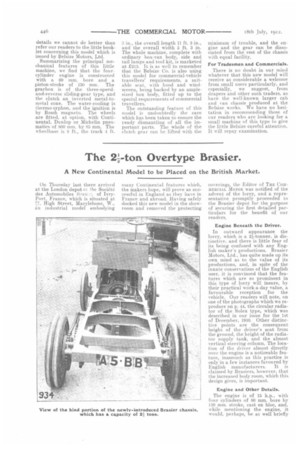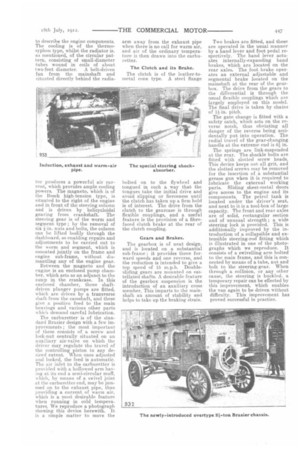The 2-..ton Overtype Brasier.
Page 8

Page 9

If you've noticed an error in this article please click here to report it so we can fix it.
A New Continental Model to be Placed on the British Market.
On Thursday last there arrived at the London depot ot the Societe des Automobiles Brasie-, of IvryPort, France, which is situated at 77, High Street, .Marylebone, W., an industrial model embodying many Continental features which, the makers hope, will prove as successful in England as they have in France and abroad. Having safely docked this new model in the showroom and removed the protecting
coverings, the Editor of TEE COMMERCIAL MOTOR was notified of the advent of the lorry, and a representative promptly proceeded to the Brasier depot for the purpose of securing the first detailed particulars for the benefit of our readers.
Engine Beneath the Driver.
In outward appearance the lorry, which is a 21-tonner, is distinctive, and there is little fear of its being confused with any English maker's productions. Brasier Motors, Ltd., has quite made up its own mind as to the value of its productions, and, in spite of the innate conservatism of the English user, it is convinced that the features which are so prominent in this type of lorry will insure, by their practical work-a-day value, a favourable reception for the vehicle. Our readers will note, on one of the photographs which we reproduce on p. 44, the circular radiator of the Solex type, which was described in our issue for the 1st of December, 1910. Other distinctive points are the consequent height of the driver's seat from the ground, the height of the radiator supply tank, and the almost vertical steering column. The location of the driver almost directly over the engine is a noticeable feature, inasmuch as this practice is only in a few instances favoured by English manufacturers. It is claimed by Brasiers, however, that the increased body room, which this design gives, is important.
Engine and Other Details.
The engine is of 15 h.p., with four cylinders of 80 mm. bore by 130 mm. stroke, cast en bloc, and, while mentioning the engine, it would, perhaps, be as well briefly
to describe the engine components. The cooling is of the thermosyphon type, whilst the radiator is as mentioned, of the circular pattern, consisting of small-diameter tubes wound in coils of about two-feet diameter_ A belt-driven fan from the mainshaft and situated directly behind the radix
tor produces a powerful air current, which provides ample cooling powers. The magneto, which is of the Bosch high-tension type, is situated to the right of the engine and in front of the steering column and is driven by helicycloidal gearing from crankshaft. The steering gear is of the worm and segment type ; by the removal of six +-in. nuts and bolts, the column can be lifted bodily through the dashboard, so enabling repairs and adjustments to be carried out to the worm and segment, which is mounted jointly on the frame and engine sub-frame, without dismantling any of the engine gear.
Between the magneto and the engine is an enclosed pump chamber, which acts as an adjunct to the sump in the crankcase. In this enclosed chamber, three shaftdriven plunger pumps are fitted, which are driven by a transverse shaft. from the camshaft, and these give a positive feed to the main bearings and various other parts which demand careful lubrication.
The carburetter is of the standard Brasier design with a few improvements; the most important of these consists of a screw and lock-nut centrally situated on an auxiliary air-valve on which the driver may regulate the travel of the controlling piston to any desired extent. When once adjusted and locked, the feed is automatic. The air inlet to the carburetter is provided with a hollowed arm having at its end a semi-circular muff, which, by means of a swivel joint at the carburetter end, may be jammed on to the exhaust pipe, thus providing a current of warm air, which is a most desirable feature when running in cold temperatures. We reproduce a, photograph showing this device herewith. It is a simple matter to move the arm away from the exhaust pipe when there is no call for warm air, and air of the ordinary temperature is then drawn into the carburetter.
The Clutch and its Brake.
The clutch is of the leather-tometal cone type. A steel flange bolted on to the flywheel and tongued in such a way that the tongues take the initial drive and avoid slipping or fierceness until the clutch has taken up a firm hold is of interest. The drive from the clutch to the gearcase is through flexible couplings, and a useful feature is the provision of a fibrefaced clutch brake at the rear of the clutch coupling.
Gears and Brakes.
The gearbox is of neat design, and is located on a substantial sub-frame ; it provides three forward speeds and one reverse, and the reduction is intended to give a top speed of 15 m.p.h. Doublesliding gears are mounted on castellated shafts. A desirable feature of the gearbox suspension is the introduction of an auxiliary cross member. This imparts to the mainshaft an amount of stability and helps to take up the braking strain. Two brakes are fitted, and these are operated in the usual manner by a hand lever and foot pedal respectively. The hand lever actuates internally-expanding band brakes, which are located on the rear axles. The foot brake operates an external adjustable and segmental brake located on the rria,inshaft, at the rear of the gearbox. The drive from the gears to the differential is through the usual flexible couplings which are largely employed on this model. The final drive is taken by chains of pitch.
The gate change is fitted with a safety catch, which acts on the reverse notch, thus obviating all danger of the reverse being accidentally put into operation. The radial travel of the gear-changing handle at the extreme end is 61in.
The springs are link-suspended at the rear. The shackle bolts are fitted with slotted screw heads. This device keeps out all grit, and the slotted screws may be removed for the insertion of a substantial grease gun when it is required. to lubricate the external working parts. Sliding sheet-metal doors give access to the engine and its components. The petrol tank is located under the driver's seat, and next to it is a tool-box of large capacity. The front and rear axles are of solid, rectangular section and of unusual strength ; a, wide steering lock is provided. This is additionally improved by the introduction of a collapsible and extensible steering-rod fitting which is illustrated in one of the photographs which we reproduce. It consists of a swivelling arm bolted to the main frame, and this is connected by means of a tube, nut and bolt to the steering-gear. When through a collision, or any other cause, the steering is buckled, a temporary repair can be effected by this improvement, which enables the van again to be driven without difficulty. This improvement has proved successful in practice.






















